Strawberries
Announcing Scholarships for the California Small Farm Conference
NOW ACCEPTING APPLICATIONS FOR SCHOLARSHIPS FOR SMALL-SCALE FARMERS
TO ATTEND THE CALIFORNIA SMALL FARM CONFERENCE
APPLICATION DEADLINE: DECEMBER 6, 2013
The California Small Farm Conference awards scholarships to small farmers and ranchers, student farmer/ranchers, farmer/rancher employees and farmer market managers to attend the conference. This year’s California Small Farm Conference will be held at the DoubleTree Hotel in Rohnert Park, CA, on March 9 – 11, 2014.Scholarships are awarded based on a number of criteria including farm and household income. Scholarship awards include registration to the three-day conference, all workshops and networking sessions, conference meals, and a Sunday Field Course at a discounted rate of $25. Lodging and travel costs are offered depending upon the distance traveled to Rohnert Park, California.
Applications may be obtained as follows:
- Download the online application from our website at: http://www.californiafarmconference.com/index.php/attend/scholarship or
- Call 1-888-712-4188 to request an application by mail or fax, or
- Email conference@californiafarmconference.com to request an application
All applications must be received by December 6, 2013. Applications received after close of business on December 6, 2013 through December 31, 2013 shall be placed on a waiting list.
About California Small Farm Conference Founded in 1982 by the Small Farm Center at the University of California, Davis, the California Small Farm Conference (http://www.californiafarmconference.com/) is the state’s premier gathering for not only small farmers, but farmers’ market managers, agricultural students, researchers, writers and food advocates to come together to network, learn, discuss and grow. The Conference is a unique opportunity for smaller-acreage producersto gain insight from technical experts, network with other farmers and ranchers, and learn sustainable farming practices, business aspects, and more.
The upcoming California Small Farm Conference will be held at the DoubleTree Hotel in Rohnert Park, CA, on March 9 – 11, 2014.
Get all the latest updates on the 27th annual California Small Farm Conference by “liking” us on Facebook http://www.facebook.com/CaliforniaSmallFarmConference where we regularly post news, photos, tips and more.
2014ScholarshipPressReleaseShort-FINAL
Base Cation Saturation Concept: Does the Ca:Mg Ratio Affect Crop Yields?
There are two ways to interpret soil testing of the cations calcium (Ca) and magnesium (Mg), from the field: one by basic cation exchange ratios and the other by sufficiency. Base cation saturation ratios appear in most soil reports (see area circled in red below) and consist of percentages of calcium, magnesium and also potassium, sodium and hydrogen. Tim Hartz from UC Davis addressed this topic head on at the recent UC Soil Fertility Short Course held on October 23.
Proponents for examining cation ratios, for example Albrecht and Stiener, have held that there is an ideal cation ratio, meaning that the optimum soil environment for crop plants occurs when the cation exchange complex is 65% Ca : 10% Mg : 5% K : 20% H. To some extent this makes sense, since it has been shown that the base saturation of an individual cation can affect its availability to plants and that the uptake of one cation may affect the uptake of others.
However, research testing a variety of ratios of cations in the soil, especially Ca and Mg, has not found much in the way of identifying a true ideal ratio. As an example given at the short course in Davis, a study in Wisconsin that doubled and even quadrupled the exchangeable Ca: Mg ratio resulted in no difference in yield of alfalfa hay per acre.
It was rather suggested that growers and managers should concentrate on making sure each nutrient is in sufficiency for plant uptake rather than on reaching some favorable cation saturation ratio.
Most California soils have an abundance of calcium and magnesium in them already. In the soil test shown below, which is from a representative raspberry soil of the Pajaro Valley, we have 4100 ppm (mg/Kg) of calcium and 670 ppm magnesium, which when we multiply times two equals 8200 lbs of calcium and 1340 lbs of magnesium in the top 6” of soil, compared to the approximately 100 lbs of calcium and 25 lbs or so of magnesium that we need for a decent berry crop. We have A LOT of calcium and magnesium in our soils.
Moreover, it’s pretty expensive to try and alter the calcium and magnesium ratios of a soil. For example, more than 1700 lbs of gypsum will be needed to be added per acre to raise the calcium by 20 ppm. So, outside of extreme misbalances of calcium and magnesium which result in structural problems like crusting, it’s probably not worth the effort and money to obtain a ratio which doesn’t seem to offer anything extra in the way of nutrient sufficiency.
In conclusion, the truth of the matter is really that even though cations do compete with another for plant uptake and have different effects on soil structure, it is nevertheless completely possible to have high plant productivity with a wide range of ratios of calcium to magnesium.
The link below is an article with a full discussion of the concept of soil cation ratios.
http://www.soils.wisc.edu/extension/wcmc/2004proceedings/Kelling1.pdf
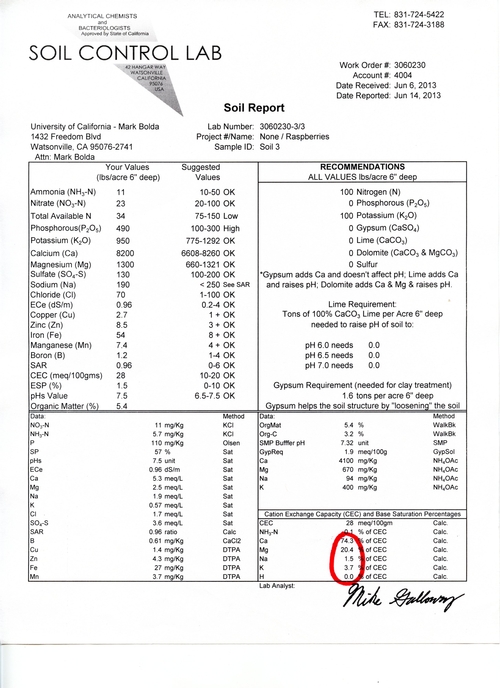
mpbolda145
J Rooting of Strawberry Plants
I have had occasion in my travels over the past two weeks to find a good quantity of what is depicted in the two photos below: J-rooting of strawberry plants.
J-rooting of strawberry plants occurs when the root is too long for the planting hole (Photo 1 below shows how big a healthy transplant can be - lots of those this year by the way) which has been made for it and subsequently the root tips end up pointing upwards rather than down. All too frequently, these upward pointing root tips end up being outside of the hole in the open air, as depicted in Photo 2 below.
It is not difficult to understand why J rooting is not beneficial to the plant. Root extension in plants takes place from the root tips, and having them exposed to the open air, drying out and dying does nothing to help this process along and represents a setback to the establishing plant. To be blunt, it’s a bad practice to be planting this way and shows a costly lack of attention to detail.
Transplanting is hard, back breaking work and it’s not too difficult to empathize and understand how J rooting can happen all too easily. Growers can help their planting crews along and get the roots straight down by several ways. Already having a deep hole or slot to be placing the transplant into helps a lot. Additionally, growers can ask that nurseries trim the roots to reduce the length of root of the transplant to better the odds of everything going straight down. In field quality control on the day of planting by the person in charge also goes a long way in making sure J rooting doesn’t become a pattern in for one individual or the crew.
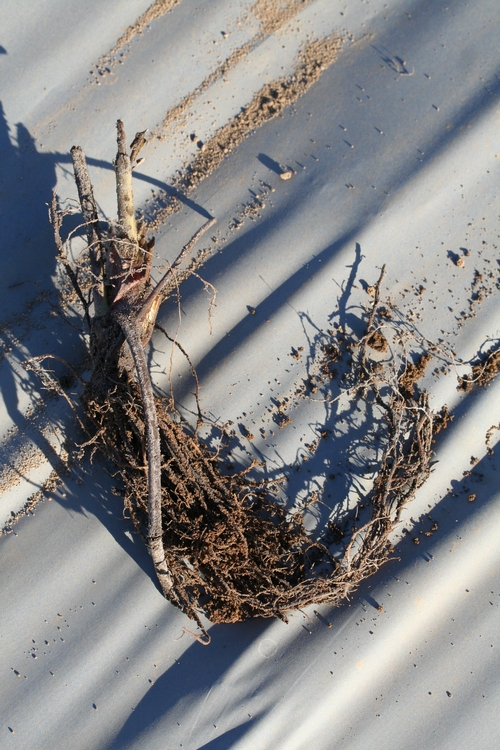
A healthy transplant showing the extent of the roots.
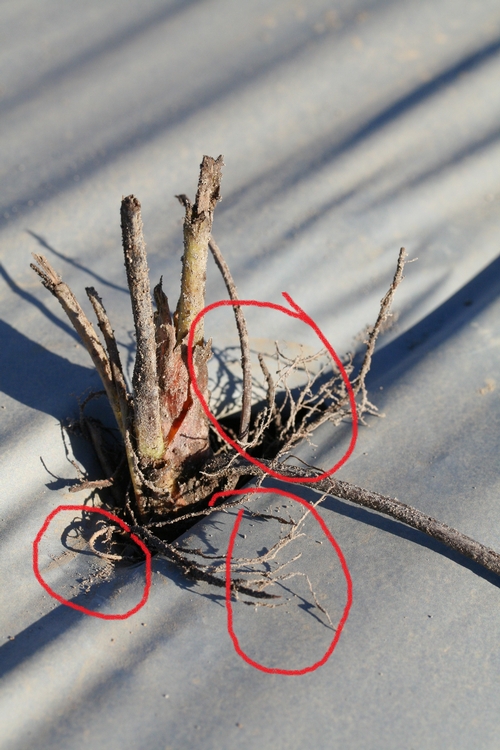
J rooted strawberry transplant showing roots exposed to the open air from improper placement in the hole.
Will the Breakup of the Potash Cartel from the former Soviet Union Affect Berry Cost of Production?
This past July the Russian potash producer OAO Uralkali threw the global potash market for a loop by halting its long running cooperation in what was essentially a cartel with the Belorusian owned producer Belaruskali, enabling it to now produce potash flat out and very likely gain a lot of market share. Not incidentally this move has landed the CEO of Uralkali in house arrest for abuse of power and embezzlement. Whatever the case may be, this decision has turned an oligopoly for potassium supply into a much freer market, and has consequently sent potash prices plummeting, crushing the shares of several listed American potash distributors in the process (Graphic 1 and 2 below).
In numbers, Uralkali plans on increasing production of potash from 10.5 million pounds this year to 13 million next year, out of a total global market of some 50 million pounds per year. According to Bloomberg, this separation of the two companies should bring the price of potash from above $400 a ton before July, 2013 to approximately $300 a ton.
What does this mean for local berry producers? Probably not a lot. First, potassium is a tiny proportion of berry cost of production of the already small cost of fertility at under 2% of the total. Second, if my experience and lots of soil and tissue samples serve me right, there is not much necessity for adding much more potassium to many of our soils! After decades of potassium fertilizer additions, this non-mobile nutrient has built up to astonishing levels in many of our fields (adequacy of K in soil in usually thought of being 200-300 ppm and in leaf tissue above 1.3% during the harvest season), meaning in most cases that required additions are quite small.
Contrast this with the case of the Central Valley for producers of heavy potassium feeding crops such as almonds for example. Scanning the Cost of Production studies for almonds, we find that annual potassium fertilizer use resides north of 5% of total costs of production, not to mention that the “potassium gravy train is coming to an end” for many other crops of the San Joaquin Valley in the words of Dr. Tim Hartz of UC Davis, with the decades long draw down of what were formerly potassium rich soils. Might be a good time for these growers to start loading that potassium back up again while prices are down.
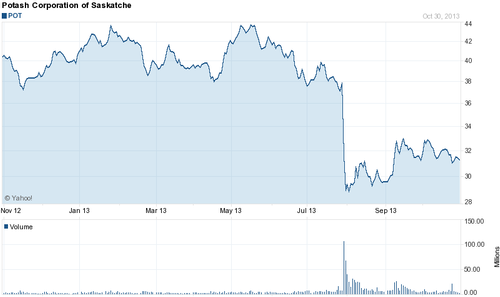
Shares of Potash Corporation pounded in late July after the break up of the Belorussian potash cartel - what does it mean for local berry producers?
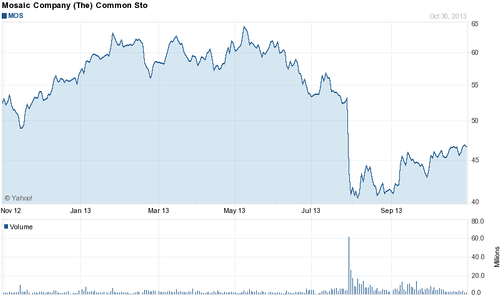
Shares of the Mosaic Company down heavily in late July after the break up of the Belorussian potash cartel - maybe a good time to bring K deficient soils back to par.
Review of Chill for the UC Day Neutral Strawberry Varieties Albion, San Andreas and Monterey
I had a conversation quite recently with Doug Shaw, UC plant breeder, concerning the concept of chill in the day neutral varieties and the desire of some Central Coast growers to reduce the recommended amounts significantly, even all the way down to zero days of chill:
In the way of review, please recall that chill requirement in strawberry in California is made up of two essential parts. One part is what the plant accumulates in the field before being harvested, and the other is accumulation of chill after harvest and the plant is in storage. There is a big difference between the two and one does not supplant the other. In-field chill takes place when the plant is still in the soil, out in the open and still has all its leaves. Supplemental chill takes place after harvest of the plant and occurs in a constant near freezing temperature, in the dark and the plant has none to very few leaves left (Figure 1 below).
Accumulation of chill, especially supplemental chill, in the strawberry transplant makes it stronger and better able to survive the stress of plant harvest, transplant and the growing season beyond.
As some of the chill sensitivity has been bred out of the modern UC day neutral varieties such as Albion, Monterey and especially San Andreas, it is indeed possible to grow these varieties with less than the recommended amounts (10-18 days) of supplemental chill. However, those who choose to reduce chill below these amounts should recognize the amount of risk they are taking and that this is not an exercise for those still using training wheels. Should growing conditions take a turn for the worse, these underchilled plants do not have the vigor to help them pull through and will suffer more than those adequately chilled. Moreover, while UC day neutral strawberry plants chilled significantly less than the recommended 10-18 days can produce fruit earlier than others (probably owing to the earlier planting date), these plants quite likely will not perform optimally in terms of overall yield and quality along with showing a tendency to produce smaller fruit later on in the season.
The only case where one would want to go short on supplemental chilling time would be if the plant harvest was so late that a minimum chill time of 10 days would result in a planting date so late that it would compromise plant growth and establishment.
Other than that, it is still recommended to give the UC day neutral varieties 10-18 days of supplemental chill.
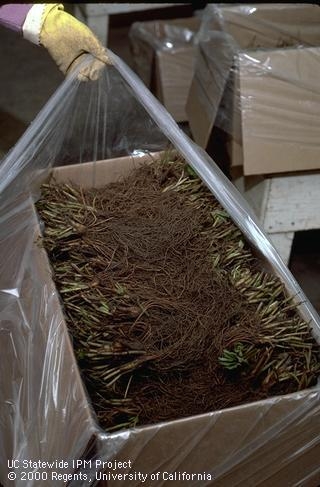
Trimmed transplants being packaged in box with polyethylene lining, ready for placement into the cooler for supplemental chilling.

